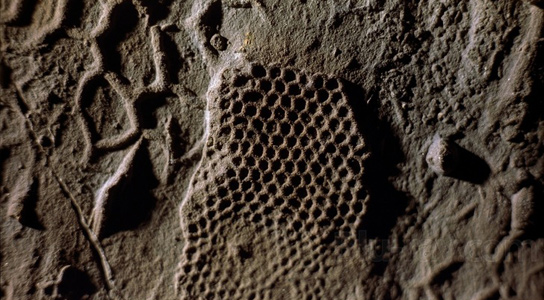Leonardo Da Vinci Fossil Sketch Might Be Depiction of Early Nests
November 19, 2012

Fossilized burrows left by Paleodictyon nodosum
500 years ago, Leonardo da Vinci briefly worked on fossils, inadvertently triggering a mystery that remains yet unsolved.
A page of Leonardo’s Paris Manuscript I is covered in sketches of marine fossils, including a honeycomb-like array of hexagons that paleontologists think might constitute the first recorded observation of Paleodictyon, an enigmatic trace fossil.

A scrawled hexagonal pattern which appears alongside some sketches of body fossils in another of da Vinci’s notebooks, Codex I.
Many paleontologists think that the imprint shows burrows made by an animal living in loose sediment on the floor. There have been specimens of Paleodictyon discovered dating back to the Cambrian Period, 542 million to 488 million years ago. Similar structures are still being found on the ocean floor today.
The identity of the animal that generates these hexagons remains a mystery. Similar, but simpler, fossils could explain why and show that organisms started caring for their young millions of years earlier than previously thought.
Mark McMenamin, a palaeontologist at Mount Holyoke College in Massachusetts, found this set of simpler fossils in 540-million-year-old limestone from the early Cambrian in Nevada and Mexico. They seem to be burrows, each a few tens of micrometers in diameter, forming swarms about 2 centimeters across.
McMenamin noticed that some of the burrow swarms cut through organic pellets, 250 to 500 micrometers in diameter, too large to have been generated by whatever made the burrows originally. He believes an unknown adult animal deposited the pellets to form a nest around a clutch of eggs, which failed to fossilize. “The hatchlings then fed on organic matter in the pellets that had been broken down by bacteria,” states McMenamin. As they ate their way through the nest, the hatchlings left the distinctive burrows that were preserved in the fossil record.
McMenamin discussed the idea at the Geological Society of America annual meeting last week in Charlotte, North Carolina. If proved correct, this interpretation would add more than 200 million years to the known record of parenting, which is complex behavior for the Cambrian.
This hypothesis might also explain why Leonardo and modern paleontologists have failed to find the animal responsible for the hexagonal burrows. In order to confirm this theory, Duncan McIlroy, a burrow specialist, believes McMenamin would need to carefully section the rock to build up a 3D picture of the burrows and look for discrete structures as part of a large, semi-permanent burrow system created by an adult organism.
No comments:
Post a Comment